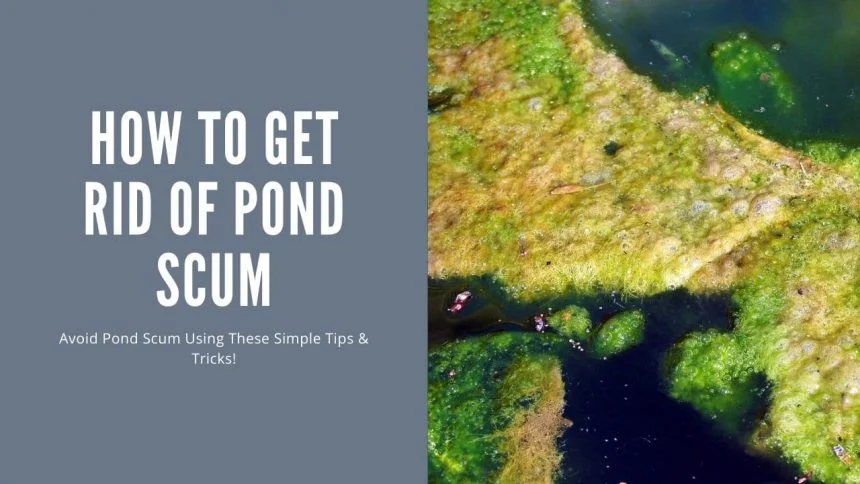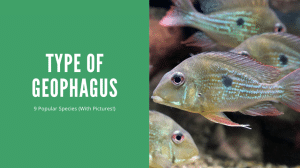Thank you for visiting! By the way… any links on this page that lead to products on Amazon and other stores/partners are affiliate links Aquarium Store Depot earns a commission if you make a purchase.
A pond or water garden comes with its own set of challenges, and pond scum is the worst of all. Pond owners never get the idea of what’s happening beneath the tranquil surface of their ponds, as on the outside, everything looks pretty calm and decent.
However, no pond is free of scum, whether it shows the signs or not. That’s because the dying or decaying materials, including twigs, fish waste, leaves, fish food, or dead algae accumulate at the bottom, leaving behind pond scum.
The formation of pond scum begins on the sides and builds up from the rocky bottom. When algae is uncontrolled, it produces oxygen that makes it buoyant, and it floats to the surface of your pond. As a result, slimy and gruesome pond scum develops that usually clings to the ponds’ wall or filters, making them impossible to remove. Once the algae grow aggressively, it messes up with your pond ecosystem and overwhelms the pond’s surface.
In this article, I’ll discuss the causes of pond scum, types of different algae, and preventive measures to control pond scum in your garden ponds.
Causes of Pond Scum
The causes of pond scum are the high level of specific nutrients, excessive daylight, and warm temperatures.
Excess nutrients, including fish waste, decaying vegetation, and fertilizers, can enter the water and feed algae, resulting in rapid multiplication of algae.
Excessive daylight is also the prime cause of pond scum, as clear shallow ponds are the breeding ground for algae forms.
Low levels of oxygen and warm temperature are also the culprits of pond scum.
To cater to these causes, pond or fountain filters must be properly maintained with the right size to prevent pond scum.
Also, limiting the number of nutrients that enter your pond should be controlled. Try to manually skim the debris and waste from a pond and remove the algae. You can also install an effective filtration system to prevent scum.
Direct sunlight adds to the pond scum. Therefore, pond dye and aquatic plants, including water iris or water lilies, should be added to reduce algae growth.
Types of Algae
There is a variety of pond algae. However, not all of them are harmful to your ponds. Some algae are beneficial that clings on the sides of your pond, producing oxygen during the day and utilize nutrients in the water. Furthermore, they provide nutrition to your pond fish.
Pond algae are divided into three primary forms; filamentous, macrophytic, and planktonic.
Filamentous Algae

Filamentous algae (Picture Source), also hair-like algae, are the most common types of algae, eerie filaments, and attach themselves to the pond’s bottom floor or rocks and aquatic plants. When the filamentous algae grow rapidly, it breaks free and floats on the surface in the form of thick algae mats or pond scum.
Filamentous algae is further classified into spirogyra, Cladophora and Pithophora.
The prevention and control of filamentous algae mats in garden ponds are easy, provided the proper treatment and early diagnosis. Depriving the filamentous algae with favorable conditions, such as nutrients and temperature, helps to control their growth and reduce the chances of potential damage to your pond and aquatic plants.
Chara
If there is a horrible onion-like smell in your pond, this is likely due to the presence of Chara algae.
Chara these freshwater algae forms grow on the bottom of the pond floor. Chara is usually misunderstood as a weed. However, it lacks roots and does not grow above the water surface.
Oscillatoria
The red-purple or bluish tint in your pond is because of Oscillotoria.
It’s freshwater, blue-green algae (cyanobacteria) that thrive in hot water springs. Oscillatoria forms blue-green mats on the bottom of the water surface. However, when they multiply, provided favorable conditions, they release and float at the water surface, making the water appear brackish.
Planktonic/Microscopic Algae
The normal production or presence of Planktonic algae is healthy for your pond as they supply your pond with dissolved oxygen, mandatory for the health of your pond and aquatic life.
However, during summers, the planktonic algae bloom, giving your pond a pea-soup coloration, and that’s when you should take preventive measures to control the plankton algae.
Since they are unicellular and multiply rapidly, you cannot detect them with your naked eye. Some common types of Planktonic algae are Chlamydomonas, chlorella, and euglena species.
How To Control Algae Naturally?
If you’re someone who doesn’t want to use chemicals, there are natural ways to control algae. The most effective ones are good water quality, pond aeration, the addition of beneficial bacteria, and the use of ultrasonic algae control.
Aeration
Ponds experts recommend using pond aeration methods to improve the overall appearance and health of the pond. Aeration will also curb pond scum growth.
To facilitate pond aeration for large ponds, the use of a land-based compressor is encouraged, which boosts the level of dissolved oxygen in your garden pond.
The Pond Pro is a land based compressor that works to aerate large ponds and lakes
For smaller to mid-sized Koi or Goldfish ponds, you can utilize aeration pumps, fountains, or an oxygenator.
This aeration kit is a great way to get added much needed aeration to your pond to prevent pond scum
Adding Beneficial Bacteria
The bacteria level in your pond should be maintained to control the situation.
- It is recommended to add beneficial bacteria in ponds where the bacterial count is low
- You can add the bacteria in liquid or powder form. Either way, they have the same function, i.e., to eliminate the pond algae and pond scum by lowering the nutrient content of the water
- Beneficial bacteria works the best to maintain the cleanliness of your pond if supported by the aeration method. Therefore, pond aeration is the primary requirement. Many DIY Pond Kits have both a filtration and aeration component.
This product is great for removing muck and nutrients from your pond rocks and surface. A great preventative for pond scum
Ultrasonic Algae Control
An advanced technology that has done wonders to control specific types of algae and pond scum in your pond is the use of ultrasonics.
- The process works by sending sound waves through water that vibrates every algae in the pond. The vibrations eventually damage the algae cell, and it dies
- Ultrasonic algae control tends to eliminate the algae alone. However, it can also be integrated with beneficial bacteria and aeration to control the algae blooms and pond scum.
A common install is an Aquascape IonGen for smaller ponds. Large ponds and lakes would look more into a commercial solution, of which KLM Solutions is the go to brand.
The Aquascape IonGen is a great low cost ultrasonic that will work in most ponds
Product Recommendations to prevent Algae Blooms
I have faced the problems of algae blooms and pond scum in my garden ponds, and so I know how badly it affects your pond ecosystem and the overall appearance.
However, I’ve tried two products and never looked back since then. I recommend using API Pond- Zyme Sludge destroyer and Cabin Obsession Pond Sludge remover to prevent algae blooms in your pond. Both work great against pond scum
But please be informed that not all ponds have the same response to the treatment
API Pond-Zyme Sludge Destroyer
This is a readily available product that works to remove sludge from your pond. Available at most pet stores
If you own a Koi or Goldfish Pond, you’d know that springs bring generous algae blooms and a foul smell that is a distraction for your visitors.
Luckily, the API pond-zyme sludge destroyer works like a charm in gulping the sludge and improves water clarity. It has pond cleaner with natural pond bacteria and barley, which breaks down fish waste and destroys pond scum and sludge effectively.
If you keep using this product religiously, I reckon it would save you a lot of money on pond maintenance and cleanliness.
Cabin Obsession Sludge Remover
This sludge remover is great for large ponds and lakes. A commercial level product at a consumer price
If you’d like to deepen your pond naturally without dredging, Cabin Obsession Pond Sludge Remover is a total steal!
It removes around 2 inches of sludge by releasing concentrated enzymes and bacteria that gulp the organic waste and destroy the muck, up to 2 inches per month. The product is all-natural and hence safe to use for fish and other aquatic life.
Cabin Obsession Pond Sludge Remover is the most affordable solution for your pond’s maintenance needs for large ponds. It comes in a bucket that would last you approximately 10 months of regular pond maintenance.
This allows you to get rid of the foul-smelling odors, ugly shorelines, and layers of pond scum with just a bucket of goodness.
FAQS
How do I get rid of pond-scum?
The easiest ways to get rid of pond scum are 1) Improve oxygen levels of your pond by proper aeration methods 2) Add aquatic plants 3) Make use of the organic, environmentally-friendly algaecide to treat your ponds 4)Reduce the use of fertilizers
What is the brown scum?
It’s pond scum. Pond scum is usually black or brown, and a slimy, sticky substance that accumulates at the bottom of your ponds. It is nothing but the decaying waste in the form of fish debris, grass clippings, dead algae. It acts as a fertilizer for the harmful pond algae, so you should treat it promptly to prevent the layers of muck from developing on the pond surface.
What causes green scum on ponds?
The green color comes from the presence of single-cell planktons in your pond, giving it a pea-soup coloration.
What does ponds scum eat?
Pond scum is algae, and algae do not consume any plants or animals. The source of nourishment for algae is sunlight, warm temperatures, and excess nutrients within your water.
How Do I Keep My Water Crystal Clear?
You should take baby steps to keep the pond water crystal clear
1) Do not overfeed your fish to prevent the accumulation of waste
2) Add lots of aquatic plants to improve oxygen levels
3) Facilitate aeration methods
4) Use beneficial bacteria to eliminate the plankton that turns the water green1)
5) Remove the debris and waste manually after feeding your fish
6) Use environmentally-friendly algaecide to keep the water clear and pond scum free
Final Thoughts
Pond scum can be a nuisance if you don’t treat it timely and maintain your pond’s ecosystem. Don’t forget to aerate your ponds and add a large biofilter to keep healthy water quality and less stressful for your aquatic life. Also, the products you use should be environmentally friendly and organic, safe to use in ponds and lakes. If you have any questions about dealing with pond scum, leave us a comment below.
- About the Author
- Latest Posts
I’m thrilled that you found Aquarium Store Depot! Here you’ll find information on fish, aquariums, and all things aquatics related. I’m a hobbyist (being doing this since I was 11) and here to help other hobbyists thrive with their aquariums! I adhere to a high quality Editorial Process and Review products with real life field usage and practical analysis.












Your didn’t mention water change. I have recirculating 3500 and a 1100 pond that are joined by a creek.
A decent water change helps hold back the muck.